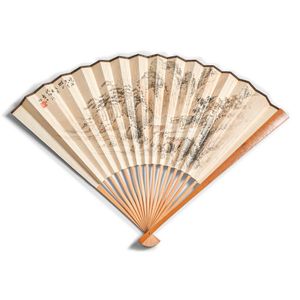Inscribed Chinese Fan with Calligraphy and Painting
An inscribed Chinese painted fan with carved bamboo guards, Republic period (1912-1949), with a calligraphic inscription to the front of two bamboo-stem poems describing lychees, by Hu Yisheng (1883-1957). The reverse with a painting of pavillions within a rocky landscape beyond a river by Shen Zhongqiang (1893-1974), dedicated to Law Ming Shek. The bamboo guards very finely and beautifully carved by Yu Chung Ka (1908-1941), the fan paper 18.2 cm high, 43 cm wide. The bamboo guards 31.3 cm long. Provenance: collection of Law Ming Shek (1899-1940), and thence by descent. Other Notes: Hu Yisheng (1883-1957) was a Chinese revolutionary who played a part in the founding of the Republic of China, Shen Zhongqiang (1893-1974) was a celebrated painter who held important positions in the Republican government. He is particularly known for his depictions of chrysanthemums, Yu Chung Ka (1908-1941) was a renowned Cantonese deaf/mute bamboo carver, Law Ming Shek (1899-1940) was from a wealthy Cantonese merchant family, worked as a stockbroker in Hong Kong, and was An important collector of Chinese paintings, calligraphy and other Chinese works of Art,
You must be a subscriber, and be logged in to view price and dealer details.
Subscribe Now to view actual auction price for this item
When you subscribe, you have the option of setting the currency in which to display prices to $Au, $US, $NZ or Stg.
This item has been sold, and the description, image and price are for reference purposes only.
- Ming Dynasty - The Ming Dynasty was a ruling dynasty of China from 1368 to 1644. It succeeded the Yuan Dynasty and preceded the Qing Dynasty. The Ming Dynasty was established by Zhu Yuanzhang, a former Buddhist monk who became a rebel leader and eventually overthrew the Mongol Yuan Dynasty. During the Ming Dynasty, China experienced a period of relative stability and prosperity. The government was centralized and bureaucratic, with the emperor at the top of the hierarchy. The Ming Dynasty is known for its cultural achievements, including the development of porcelain, the invention of movable type printing, and the construction of the Great Wall of China.
- Important - Important is a word used in the antique trade to indicate an object should be ranked above other similar objects, and is therefore more valuable.
The object could be considered important because it is by a famous designer or maker, has been shown at a major exhibition, is of exquisite workmanship, is rare or is a "one-off", was made for an important patron, and so on.
Even further up the pecking order are objects that are described in catalogue descriptions as highly important or extraordinarily important. - Republic Period - The Chinese Republic period, also known as the Republic of China period, lasted from 1912 to 1949. It began with the overthrow of the Qing Dynasty in 1911 and the establishment of the Republic of China under Sun Yat-sen. During this period, the country underwent significant political, social, and economic changes, including the adoption of a new constitution, the expansion of civil liberties, and the modernization of the economy. However, the Republic of China period was also marked by political instability, with numerous warlords and factions vying for power and influence, and the country was eventually engulfed in a civil war between the Nationalists and the Communists. The Republic of China period came to an end in 1949, when the Communists emerged victorious and established the People's Republic of China, while the Nationalists retreated to Taiwan where they established a separate government.
This item has been included into following indexes:
